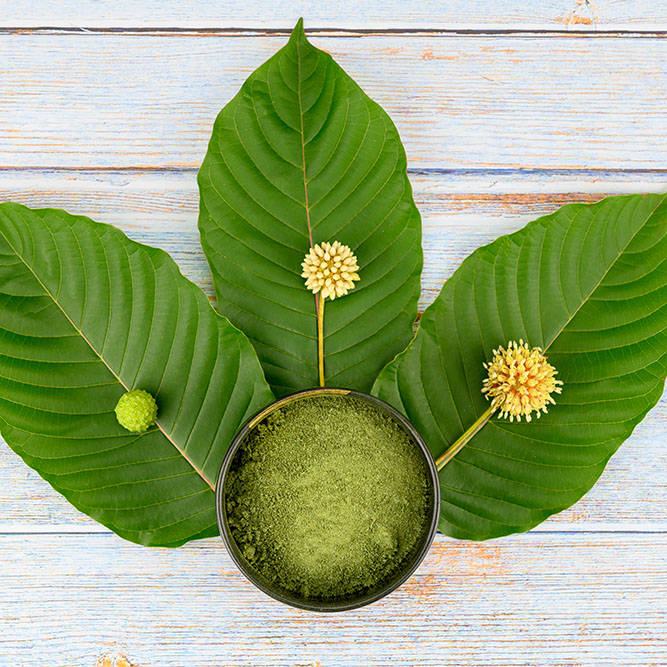The first thing to understand about kratom is that all kratom comes from the same plant, the Mitragyna speciosa — a member of the coffee family. You will often hear kratom types referred to by color: white, green, yellow, and red. These colors indicate the color of the vein of the leaf when it was harvested. However, the strain of the plant often refers to the geographic location of where the plant was grown in combination with the vein color. For instance: green vein Bali kratom, or Indo red vein kratom.
Veins and Color
There are four common colors of kratom veins. As the kratom plant ages and matures, the veins of the kratom leaf change colors. The pharmacology of the plant, the compounds, alkaloids, and properties, are said to change in concentration in the leaves as the plant ages. Similar to tea leaves, the vein color can also indicate the age of the leaf when it was harvested. In short, different colors or veins of kratom have different uses.
White Vein Kratom
White vein kratom is harvested from leaves at their youngest point in the development cycle. Technically, it’s a very light shade of green. White vein kratom contains high concentrations of mitragynine and is known for its energy-boosting effects, its ability to help users focus, the feeling of increased stamina, and the support of a positive mood.
Green Vein Kratom
Green vein kratom is harvested from leaves that have yet to reach full maturity. As the leaf begins to mature, it produces the classic green color that mimics the flesh of the kratom leaf itself. It’s during this period of time that the leaf is taking in the most energy it can possibly acquire from the sunlight. Green vein kratom is known for its support in enhancing alertness and focus, easing discomfort, to soothe feelings of unease, and to enhance social feelings.
Red Vein Kratom
Red vein kratom is harvested when leaves have reached their full maturity. As the plant matures, a kratom leaf’s vein will begin to darken to an amber color. This reddish hue provides the kratom farmers with a tell-tale sign that the leaf is ready for harvest. At this stage of growth, pigments called anthocyanins are becoming more abundant throughout the leaf. Red vein kratom is known as the most commonly used type. Red vein kratom is known for its calming and sedative effects, and is used to ease physical discomfort, aid relaxation, and help achieve sleep.
Yellow Vein Kratom
Yellow vein kratom is a more recent development in the world of kratom. There are a few theories on how yellow vein kratom is produced. One theory states that yellow vein kratom leaves are harvested late in the lifespan of the Mitrayna speciosa’s life span, giving the vein a yellow hue. Other theories state that yellow vein kratom is created by processing the plant after harvest, rather than during the plant’s actual growth process. These theories include methods of drying, fermenting, and blending white, green, and red vein kratom leaves together to create yellow kratom. Due to the relative novelty of yellow vein kratom strains, and ambiguity about the actual production and cultivation methods behind them, it can be more difficult to find reputable sellers who are able to source yellow kratom, and it may not be available in as many different strains as the more common vein colors are.
Strains and Varieties
Kratom strains and varieties are the subtypes of kratom products. The strain generally notes the geographic location that the kratom comes from along with the vein color to indicate a specific growth characteristic of the kratom plant. Varieties may also indicate a mixture or blend of kratom strains or how the kratom is processed. Kratom strains are often sold using labeling that describes both the vein color as well as the geographic location to indicate the strain’s properties or speeds and effects.
Thai
Thai Kratom is grown in the country of Thailand and can be purchased as:
- Green Thai: is known to aid the relief of physical discomfort, help enhance focus and concentration, uplift the mood, and increase sociability.
- White Thai: is known as a potent strain that is known to increase energy and to help provide temporary relief from physical discomfort.
- Red Thai: is a popular strain and is commonly used by those that are new to kratom. Red Thai is known for promoting feelings of relaxation.
Bali
Bali kratom is grown on the Indonesian island of Bali and can be purchased as:
- Green Bali: is a popular strain used by those that are new to kratom. It is typically used to relieve feelings of unease and uplift the mood without feelings of sedation.
- White Bali: is commonly taken to uplift the mood and promote relaxation. It is also known for its help in relieving physical discomfort without any sedative effects.
- Red Bali: is known as a mild strain that is commonly used by those that are new to kratom. Red Bali is typically taken to relieve physical discomfort and promote relaxation.
Sumatra
Sumatra kratom is grown on the large Indonesian island of Sumatra and can be purchased as:
- Green Sumatra: is known as one of the stronger kratom strains and is commonly used to boost energy, promote relaxation, and temporarily relieve physical discomfort.
- White Sumatra: is known for long-lasting feelings of relaxation and ease of emotional discomfort and feelings of unease. It is also commonly taken to support sleep.
- Red Sumatra: is a slow strain known to support relaxation and sleep.
- Yellow Sumatra: is known to boost energy and concentration as well as uplift the mood.
Borneo
Borneo kratom is grown on the Borneo island in the Southeast Asian Malay archipelago. Borneo kratom can be purchased as:
- Green Borneo: is typically known for its higher potency and its reported assistance in helping to relieve physical discomfort and uneasy feelings while enhancing sociability.
- White Borneo: is known for its coffee-like temporary effects of increased alertness, focus, and supporting mental function.
- Red Borneo: is commonly used to relieve physical discomfort and uplift the mood.
- Yellow Borneo: is known for uplifting the mood and relief of physical discomfort.
Malay
Malay kratom is grown in the Southeast Asian country of Malaysia and can be purchased as:
- White Malay: is known for uplifting the mood and boosting energy.
- Green Malay: is known as a potent strain that is used to aid relief of physical discomfort while uplifting the mood.
- Red Malay: is known for promoting relaxation and relief of physical discomfort.
- Yellow Malay: is used to increase alertness and energy, and for relief of physical discomfort.
Indo
Indo kratom is grown in the Republic of Indonesia and can be purchased as:
- White Indo: is known for the reputed benefits of temporary relief from physical discomfort with less sedative effects.
- Green Indo: is known as a more mild strain that boosts energy, aids in relief from physical discomfort, and uplifts the mood.
- Red Indo: is one of the most popular strains of kratom and is known to help relieve physical discomfort, uplift the mood, and promote relaxation.
Maeng Da
Maeng Da kratom is commonly known as the strongest variety with maximum potency. Although the term comes from Thai slang for “pimp grade,” Maeng Da kratom can be grown in any region, as well as harvested from any color of vein. What sets Maeng Da apart from other geographic strains is the crossbreeding technique used to grow it. Maeng Da kratom is grown by grafting a sapling to a mature tree.
- Green Maeng Da: is known as one of the strongest kratom strains and is typically used to aid in the relief of physical discomfort and boosting the mood.
- White Maeng Da: is known for its temporary relief of physical discomfort with the addition of enhancing energy.
- Red Maeng Da: is sometimes used to relieve physical discomfort without any feelings of sedation.
Bentuangie
Bentuangie kratom is grown in the Bentuangie region of Indonesia. Rather than the typical process of drying and crushing kratom leaves, Bentuangie kratom is fermented before it is dried. It is known for the temporary relief of physical discomfort, the promotion of feelings of calm or relaxation, as well as its reputed benefits for reducing feelings of unease.
Not only are there many types and strains to choose from that each tout their own reputed lifestyle benefits, but there are also many ways to take kratom and explore the proper dosage for you. You can take kratom in capsule form, brew kratom tea, add kratom powder to foods or beverages, take kratom extracts, and even smoke kratom. With all of the options and opportunities to enjoy kratom, you can curate the best experience for yourself while enjoying the lifestyle benefits of the Mitragyna speciosa plant.






